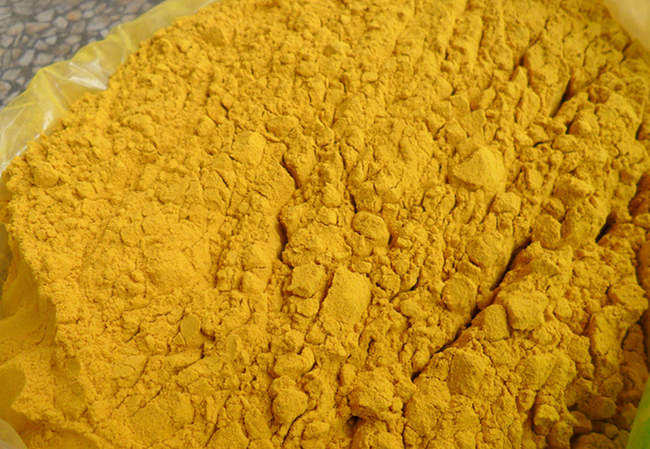Medicinally cattails mainly refers to the dried pollen of a series of cattails genus species in the family Typhaceae, including Typha angustifolia L. (narrow leaf cattail, lesser bulrush, or jambu), Typha latifolia L, Typha orientalis Preel, Typha angustata Bory et Chaub., and more. And other names of this herb include reedmace, bulrush, catninetail, raupo, punks, cumbungi, corn dog grass, and so on. In China it is mainly produced in provinces of Zhejiang, Jiangsu, Anhui, Hubei, and Shandong. The yellow male inflorescence, located at the top of cattail flower spikes, is usually collected in summer. After that, it needs to be dried in the sun, ground, and sifted for the fine powder. It is generally used raw or fried.
Typha angustifolia, also known as narrow leaf cattail, is a perennial herb, 1.5 to 3 meters in height. Creeping rhizomes are with many fibrous roots. Leaves are narrowly linear, 5 to 8mm wide, or rarely up to 10mm. Small flowers are unisexual and monoecious; brown spica is long and cylindrical; pistillate and staminate inflorescences are detached. Staminate inflorescence, 20 to 30cm long, is in the upper part and pistillate inflorescence, 9 to 28cm long, is in the lower part and with caducous leafy bracts; male cattail flower have 2 to 3 stamens, basal hair that is longer than the anthers, single or 2 to 3 pronged apex, and solitary pollen grain; spatulate female flowers are bracteolate, shorter than the stigma but as long as the bracteole, and with caducous fuzz and linear or linear-round stigmas. Cluster is 10 to 15cm in diameter. Small nuts are indehiscent and with no grooves. And the epicarp separates from the hard inner shell. Bloom time is from June to July and fruiting time is from July to August. Main cattails habitat is shallow water.
CATTAILS BENEFITS
Cattails plant is also an edible crispy wild vegetable, especially the soft white part of cauloid and young part at the tip of cattail roots . For example, Nai Tang Pu Cai (milk soup of cattail) is a famous soup in Shandong Cuisine, one of the Eight Cuisines in China. This is a famous specialty of Jinan cuisine, which is based on the tender cattail plant that grows by the Daming Lake. As a matter of act, the popularity of this dish can be even dated back to as early as in Ming and Qing Dynasties. Thanks to its milky white color, crisp texture, and refreshing light flavor, it becomes a regular in high grade feasts. No wonder it enjoys the reputation as "the first soup of Jinan cuisine".
Cat tail plant is also an important raw material for manufacturing paper and rayon. Besides, its leaves are widely used to weaving shoes, fans, mats, baskets, and other useful crafts that are of high artistic and aesthetic values. And cattail wool, the hairs on the female inflorescence, is often used for stuffing pillows.

Cattails
As mentioned above, cattails pollen is the main medicinal part, which is with cardiotonic and lipid-lowering effects. The cat-tail-pollen based compound preparations can dilate coronary artery, reduce lipid, and prevent and treat atherosclerosis. Hence, clinically it has a certain effect in the treatment of coronary heart disease, angina, and hyperlipidemia. As a traditional Chinese herb, it has long been considered a good herb for activating blood and dissolving stasis, removing stasis to relieve pain, and inducing diuresis for treating stranguria. In fact, it also works on lowering lipid to unclog arteries and treating hyperlipidemia. This is because this herb can inhibit lipid deposition in the arterial wall, thus effectively delay the process of atherosclerosis, which in turn reduce total cholesterol, lower blood pressure, dilate blood vessels, and improve microcirculation.
CATTAILS RECIPES ON HERBAL REMEDIES
The Chinese Materia Medica believes that cattails are sweet and slightly acrid in flavor and neutral in nature. It covers meridians of liver, heart, and spleen. Basic functions are stopping bleeding, removing stasis, and promoting diuresis. Principal cattail uses and indications include hemoptysis, nosebleed, dysentery, blood in the stool, bloody flux, uterine bleeding, traumatic bleeding, cardiodynia and abdominal pain, amenorrhea-induced abdominal pain, postpartum stasis-induced pain, Dysmenorrhea, pain or swelling after a fall and twisting injury, difficult painful urination in bloody stranguria, vaginal discharge, redness or swelling in bottom and root of the tongue, mouth sores, acute or chronic suppurative ear diseases, and wet itchy groin or crotch. Recommended dosage is from 5 to 10 grams in decoction, pills or powder.
1. Pu Huang Wan from Sheng Ji Zong Lu (Complete Record of Holy Benevolence). It is formulated with Long Gu (Dragon Bones) and Ai Ye (Mugwort Herb) to treat abnormally heavy or prolonged menstruation.
2. Shi Xiao San from Tai Ping Hui Min He Ji Ju Fang (Formulas of the Peaceful Benevolent Dispensary). It is coupled with Wu Ling Zhi (Faeces Trogopterori) to make cream for the treatment of tremendous postpartum pain in heart and abdomen.
3. Pu Huang San from Complete Record of Holy Benevolence. It is matched with Yu Jin (Tumeric Tuber) to cure heat in bladder and blood in the urine.

![Diseases, Symptoms, tcm, [tcmwindow.com]](/uploadFile/adImg/2015/11/11/f5cbfcc0-4df5-4646-9b9a-f316651a0199.jpg)





